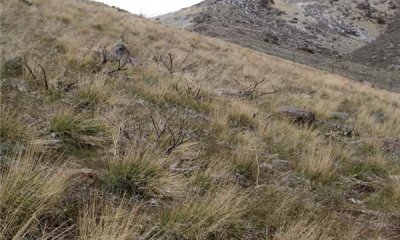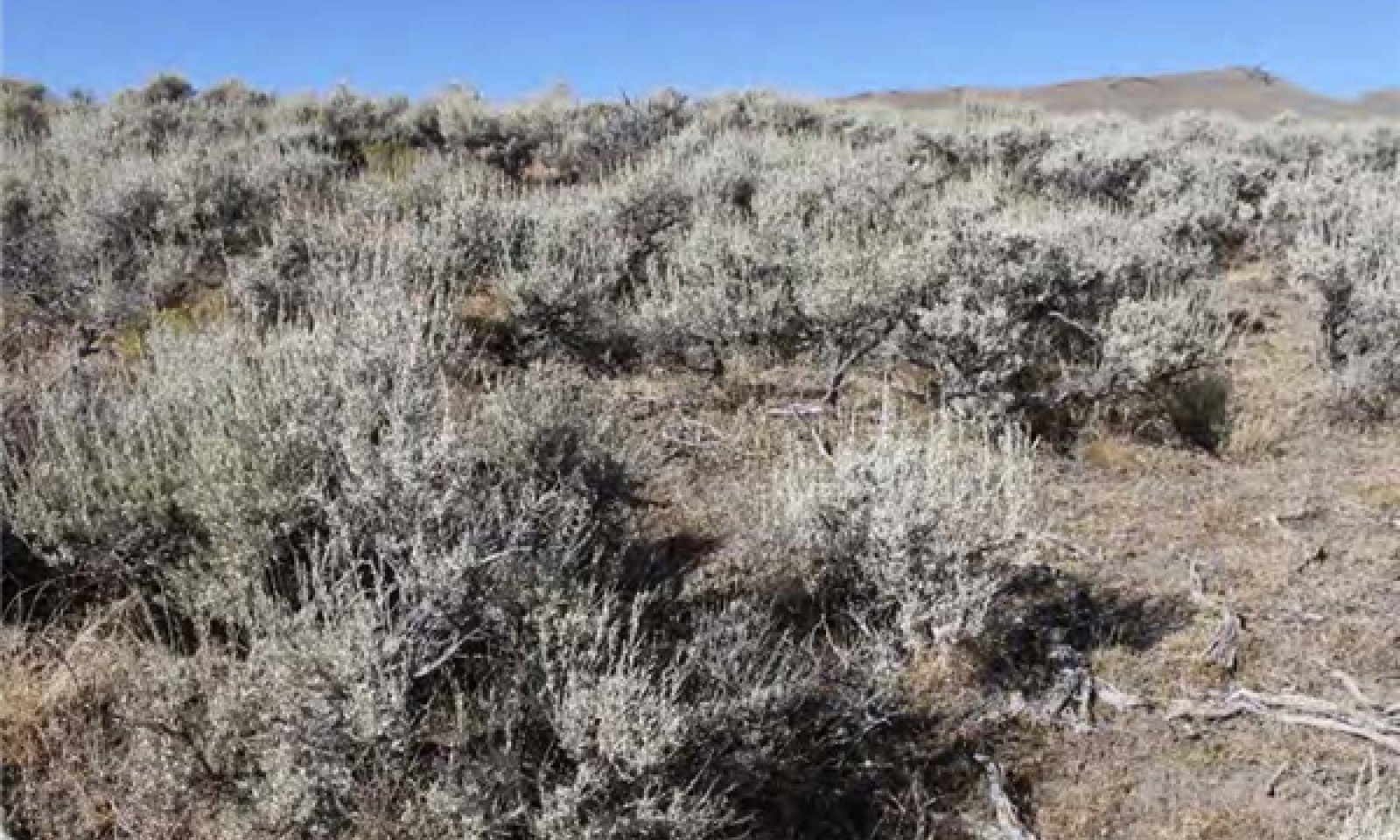
SOUTH SLOPE 12-16 P.Z.
Scenario model
Current ecosystem state
Select a state
Management practices/drivers
Select a transition or restoration pathway
-
Transition T1A
Introduction of non-native species
More details -
Transition T2A
Loss of deep-rooted perennial grasses
More details -
Transition T2B
Increased size and frequency of wildfire
More details -
Transition T2C
Increase cover and regeneration of tree species
More details -
Restoration pathway R3A
Brush management, seeding with native species
More details -
Transition T3A
Increased size and frequency of wildfire and/or soil disturbing treatments
More details -
Transition T3B
Increase cover and regeneration of tree species
More details -
Restoration pathway R5A
Tree removal and seeding with native species
More details -
Restoration pathway R5B
Tree removal
More details -
Transition T5A
Increased size, intensity and frequency of wildfire
More details -
No transition or restoration pathway between the selected states has been described
Target ecosystem state
Select a state
Description
The Reference State 1.0 is a representative of the natural range of variability under pre Euro-settlement conditions. State dynamics are maintained by interactions between climatic patterns and disturbance regimes. Negative feedbacks enhance ecosystem resilience and contribute to the stability of the state. These include the presence of all structural and functional groups, low fine fuel loads, and retention of organic matter and nutrients. Plant community phase changes are primarily driven by fire, periodic drought and/or insect or disease attack.
Submodel
State 2
Current Potential State





Description
This state is similar to the Reference State 1.0. Ecological function has not changed, however the resiliency of the state has been reduced by the presence of invasive weeds. Non-natives may increase in abundance but will not become dominant within this State. These non-natives can be highly flammable, and can promote fire where historically fire had been infrequent. Negative feedbacks enhance ecosystem resilience and contribute to the stability of the state. These include the presence of all structural and functional groups, low fine fuel loads and retention of organic matter and nutrients. Positive feedbacks decrease ecosystem resilience and stability of the state. These include the non-natives’ high seed output, persistent seed bank, rapid growth rate, ability to cross pollinate and adaptations for seed dispersal.
Submodel
Description
This state is characterized by the reduction or loss of deep-rooted perennial bunchgrasses. It is typically the product of many years of heavy grazing during time periods harmful to perennial bunchgrasses. Sandberg bluegrass has increased and become the dominant grass on site. Sagebrush dominates the overstory and rabbitbrush may be a significant component. Sagebrush cover exceeds site concept and may be decadent, reflecting stand maturity and lack of seedling establishment due to competition with mature plants and the redistribution of soil moisture resources off-site.
Submodel
Description
This state is characterized by the dominance of annual non-native species and a narrowed fire return interval. Annual non-natives are controlling site dynamics and native perennials are reduced in cover, vigor and reproductive capacity or absent. Sprouting shrubs such as rabbitbrush, snowberry, or ephedra may dominate the overstory, depending on time since fire/disturbance.
Submodel
Description
This state is characterized by the dominance of Utah juniper and singleleaf pinyon in the overstory. Big sagebrush and perennial bunchgrasses may still be present, but they are no longer controlling site dynamics in this state. Soil moisture, soil nutrients and soil organic matter distribution and cycling have been spatially and temporally altered and are being controlled by trees.
Submodel
Mechanism
Trigger: Introduction of annual non-native species
Slow variable: Over time the annual non-native plants will increase within the community decreasing organic matter inputs from deep-rooted perennial bunchgrasses resulting in reductions in soil water availability for perennial bunchgrasses.
Threshold: Any amount of introduced non-native species causes an immediate decrease in the resilience of the site. Annual non-native species cannot be easily removed from the system and have the potential to significantly alter disturbance regimes from their historic range of variation.
Mechanism
Trigger: To Community Phase 3.1: Inappropriate grazing will decrease or eliminate deep rooted perennial bunchgrasses, increase Sandberg bluegrass and muttongrass and favor shrub growth and establishment. To Community Phase 3.2: Severe fire in community phase 2.3 will remove sagebrush overstory, decrease perennial bunchgrasses and enhance Sandberg bluegrass and muttongrass. Annual non-native species will increase.
Slow variables: Long term decrease in deep-rooted perennial grass density resulting in decreased organic matter inputs, reduced infiltration and increased runoff.
Threshold: Loss of deep-rooted perennial bunchgrasses changes nutrient cycling, nutrient redistribution, and reduces soil organic matter and soil moisture storage.
Mechanism
Trigger: Multiple fires and/or soil disturbing treatments such as drill seeding, roller chopper or Lawson aerator
Slow variable: Increased production and cover of non-native annual species.
Threshold: Loss of deep-rooted perennial bunchgrasses and shrubs changes nutrient capture and cycling within the community. Increased, continuous fine fuels modify the fire regime by changing intensity, size and spatial variability of fires. Frequency of disturbance is controlling size resources.
Mechanism
Trigger: Absence of disturbance over time, natural regeneration and the presence of a pinyon/juniper seed source
Slow variables: Increased establishment and cover of pinyon/juniper trees
Threshold: Trees overtop big sagebrush and out-compete shrubs for water and sunlight. Spatial distribution of runoff and infiltration is controlled by dominance of trees. Precipitation and organic matter are being transported off-site due to runoff.
Mechanism
Brush management with minimal soil disturbance/ coupled with seeding of deep-rooted perennial native bunchgrasses. Probability of success very low.
Mechanism
Trigger: Severe, repeated, fire and/or soil disturbing treatments
Slow variables: Increased production and cover of non-native annual species.
Threshold: Increased, continuous fine fuels modify the fire regime by changing intensity, size and spatial variability of fires. Changes in plant community composition and spatial variability of vegetation due to the loss of perennial bunchgrasses and sagebrush truncate energy capture and impact the nutrient cycling and distribution.
Mechanism
Trigger: Absence of disturbance, natural regeneration overtime and the presence of a pinyon/juniper seed source
Slow variables: increased cover and size of trees results in changes to nutrient cycling, soil moisture, and energy capture.
abundance and increase resulting in reduced infiltration and increased runoff.
Thresholds: Abundance of trees is controlling site dynamics. Trees are controlling the spatial and temporal distribution of precipitation, soil moisture availability and nutrient cycling. Understory is significantly impacted due to shading, truncating energy transfer on the site.
Mechanism
Attempts to restore this site should include tree removal, followed by seeding with perennial natives. Failed restoration efforts may result in a transition to the Annual dominated state. Probability of success is low and care should be taken to minimized soil disturbing practices.
Mechanism
Removal of trees using minimal soil disturbing practices. With out seeding deep-rooted perennial bunchgrasses Sandberg bluegrass will remain dominant in the understory. A failed restoration attempt or use of soil disturbing practices may result in a annual dominated state.
Mechanism
Trigger: Catastrophic crown fire or Inappropriate tree removal practices such as chop and burn when annual non-natives such as cheatgrass are present.
Slow variable: Increased seed production and cover of annual non-native species. Decreased infiltration and increased runoff result in reduction in soil water.
Threshold: Increased, continuous fine fuels modify the fire regime by changing intensity, size and spatial variability of fires. Changes in plant community composition and spatial variability of vegetation due to the loss of perennial bunchgrasses and sagebrush truncate energy capture and impact the nutrient cycling and distribution.
Model keys
Briefcase
Add ecological sites and Major Land Resource Areas to your briefcase by clicking on the briefcase (![]() ) icon wherever it occurs. Drag and drop items to reorder. Cookies are used to store briefcase items between browsing sessions. Because of this, the number of items that can be added to your briefcase is limited, and briefcase items added on one device and browser cannot be accessed from another device or browser. Users who do not wish to place cookies on their devices should not use the briefcase tool. Briefcase cookies serve no other purpose than described here and are deleted whenever browsing history is cleared.
) icon wherever it occurs. Drag and drop items to reorder. Cookies are used to store briefcase items between browsing sessions. Because of this, the number of items that can be added to your briefcase is limited, and briefcase items added on one device and browser cannot be accessed from another device or browser. Users who do not wish to place cookies on their devices should not use the briefcase tool. Briefcase cookies serve no other purpose than described here and are deleted whenever browsing history is cleared.
Ecological sites
Major Land Resource Areas
The Ecosystem Dynamics Interpretive Tool is an information system framework developed by the USDA-ARS Jornada Experimental Range, USDA Natural Resources Conservation Service, and New Mexico State University.


